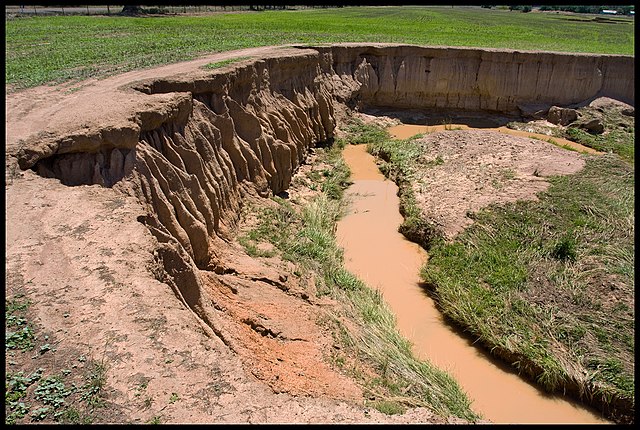2 13.3 Challenges Faced by Soils, Challenges Posed by Soils
Katherine J. Megivern
Erosion
Like all geological materials, soil is subject to erosion, although under natural conditions on gentle slopes, the rate of soil formation either balances or exceeds the rate of erosion. Human practices related to forestry and agriculture have significantly upset this balance, however.

Soils are held in place by vegetation. When vegetation is removed, either through cutting trees or routinely harvesting crops and tilling the soil, that protection is either temporarily or permanently lost. The primary agents of the erosion of unprotected soil are water and wind.
Water erosion is accentuated on sloped surfaces because fast-flowing water has higher eroding power than still water. Raindrops can disaggregate exposed soil particles, putting the finer material (e.g., clays) into suspension in the water. Sheetwash, unchannelled flow across a surface, carries suspended material away, and channels erode right through the soil layer, removing both fine and coarse material.
Wind erosion is also exacerbated by the removal of trees that act as windbreaks and by agricultural practices that leave bare soil exposed. Tilling is another factor in soil erosion, especially on slopes, because each time a cultivator lifts the soil, it is moved a few centimeters down the slope.
Biological Soil Crusts
With soil more exposed in deserts compared to other habitats, the risk of wind and water erosion is especially high. But biological soil crusts involving various proportions of cyanobacteria, algae, lichens (described below), mosses, and liverworts help shield and stabilize desert soils. (Other names for these crusts include cryptobiotic soils and microphytic crusts.)
Cyanobacteria in deserts often occur as filaments with sheaths. They contribute a sticky substance that holds together soil particles. The sheaths remain even after the cyanobacteria die and continue to bind soil particles as they accumulate to depths of over 15 cm, or 6 inches.
Lichens represent a symbiotic relationship between fungi and algae or cyanobacteria. The fungi create fine filaments (hyphae) that help further bind the soil particles. Cyanobacteria fix atmospheric nitrogen. Photosynthetic algae help energize the partnership through photosynthesis. When dry, the crust is dormant and dark in color; when wet, it is active and at least somewhat green.
Video 13.3.1. Cryptobiotic Soils. (1:19) Shown here is dramatic evidence of the presence of chlorophyll (which is used in photosynthesis) in this biological soil crust.
Biological soil crusts have different appearances in different areas. Most look inviting to step on. But resist the temptation, as they are protecting soil and can take even a century to recover. Meanwhile, water and wind erode the precious soil. Recreational vehicles and livestock produce even more severe damage. Soils often take 5,000-10,000 years to develop in deserts. Biological soil crusts are an invaluable protection. Video 13.3.2. Biological Soil Crust. (3:10). This is an excellent summary of biological soil crust with memorable images.
An excellent discussion of the many unique features of desert soils can be found in the comprehensive Desert Soils article on the Sonora Desert Museum website.
Problem Soils
Problem soils pose costly hazards across the US, and Arizona has its share. One major problem is expansive soils that are prone to shrink/swell cycles due to variable water content facilitated by clay. Such change can damage homes, streets, pipelines, etc., more effectively than even floods and tornadoes. Another problem soil is termed collapsing soil. Unlike clay that has flat particles that stack snugly, collapsing soils are made up of loosely packed dry sediments. Weight added to these soils, whether it be by water, a building or pavement, will cause the soil to shrink and collapse. For homeowners, avoiding adding water near their foundation can help decrease the risk.
Geotechnical engineering, a branch of civil engineering, applies an understanding of soil and rock mechanics to human building endeavors.
the process in which a material is worn away by a stream of liquid (water) or air, often due to the presence of abrasive particles in the stream
working the soil in preparation for raising crops; for example, plowing
microorganisms that are related to bacteria and are photosynthetic
a more primitive type of plant characterized by leaflike lobes, no vascular (tube) system, no flowers, and spore production

